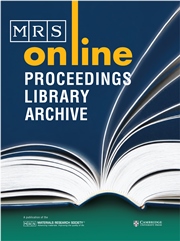Article contents
Oxygen Adsorption on and Oxidation of NiAl Surfaces
Published online by Cambridge University Press: 25 February 2011
Abstract
Oxygen adsorption on and the eventual oxidation of the (100), (110), and (111) surfaces of NiAl was studied extensively using a variety of surface sensitive techniques. While the initial rate of uptake at 22°C varied significantly with orientation and surface composition, in all cases it was possible to form an overlayer region containing the equivalent of several monolayers of oxygen. No ordered overlayers were observed. Information about the chemical bonding was obtained from changes in core-level binding energies. Examination of the Al 2p region showed evidence for two different oxide environments, depending on surface treatment. Comparison of these results with those for both Ni and Al clearly shows effects due to alloying.
Information
- Type
- Research Article
- Information
- Copyright
- Copyright © Materials Research Society 1987
References
REFERENCES
- 2
- Cited by

